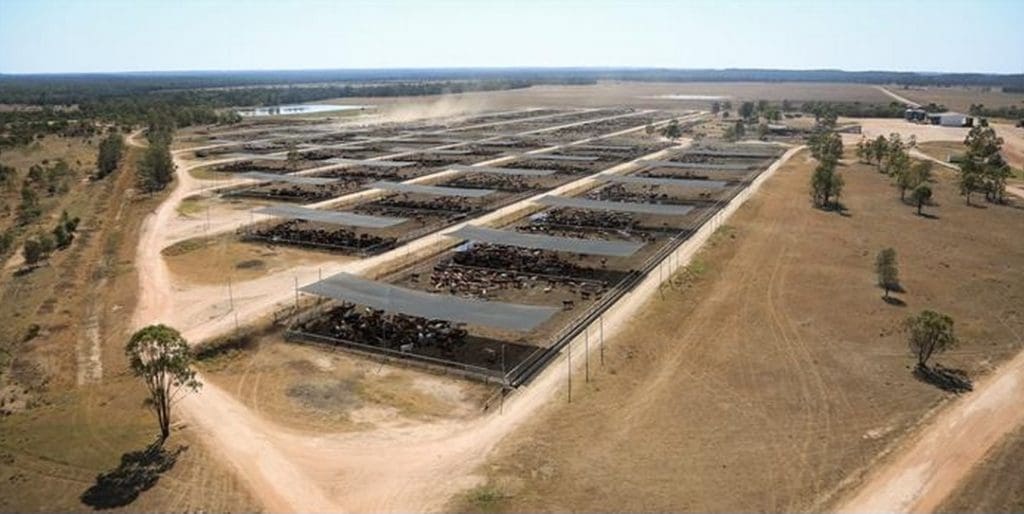THERE has been a strong sequence of substantial feedlot sales across Eastern Australia after a lengthy period of little or no transaction activity.
Teys Australia kick-started the trend 12 months ago when it purchased the 20,000 head Charlton feedlot, one of Victoria’s biggest beef feedlots, from Elders for more than $10 million.

New owner, ACC plans to expand the Opal Creek yard out to 30,000 head capacity, as part of a supply chain insurance strategy
In June this year, Australian Country Choice, which supplies exclusively to Coles supermarkets, secured the Opal Creek feedlot near Cecil Plains on Queensland’s Darling Downs for more than $6 million, with plans for a major expansion.
A month later, northern NSW meat processor, Bindaree Beef Group bought its first feedlot, the 20,000 head Myola yard near North Star, not far from the Queensland/NSW border. Not long after, Chinese interests purchased the The Mount feedlot near Forbes, NSW.
Toowoomba-based senior rural valuer with Herron Todd White, Doug Knight, is regarded as something of a specialist in feedlot valuation. He said most recent sales had been motivated by established processor-driven beef supply chains looking to strengthen and better secure cattle supply.
Tim McKinnon, Senior Director CBRE Agribusiness, agrees with the sentiment. “Higher beef prices are driving processor demand and as a result, processors are trying to shore-up livestock supply,” he said.
“There is also a drought affecting most of Queensland that is forcing cattle on to feed. We are now seeing the majority of feedlots operating at or near capacity.”
The situation is reflected in the June 30 quarterly feedlot survey published recently, which showed numbers on feed across Australia at close to 957,000 head – close to the all-time record (see graph below – click on image for a larger view).
“For the first time in quite some years, we are seeing a number of processors purchasing their own, or additional feedlots,” Mr McKinnon said.
Earlier acquisitions by processors tended to come via mergers or acquisitions of processing operations, that also included feedlot assets. Examples included:
- JBS’s purchase of the Tasman group, including the Yambinya feedlot in addition to several processing plants
- Teys merger with Cargill Australia, which provided access to the Jindalee feedlot in addition to Teys’ existing Queensland feedyard, and
- JBS’s purchase of the Rockdale Beef integrated processing and feedlot interests near Yanco, NSW.
In all three cases, it was impossible to determine the value of the feedlot infrastructure involved at time of transaction, because it was part of a broader suite of assets.
The recent sales and a renewed interest in feedlot purchases, however mean it is now easier to establish a benchmark for the value of a feedlot, property industry contacts say.
Tim McKinnon said the recent transactions had given valuers a guide.
“Up until recently it had been very difficult to establish benchmarks for feedlot value, given the extreme lack of sales.”
HTW’s Doug Knight said while it was helpful to have a good understanding of the actual feedlot to determine its likely value, being able to benchmark that yard against others on the market was a useful tool.
“There are a number of factors that need to be determined. Location is critical (relatively both grains and roughage supply, and cattle supply), the replacement cost of the feedlot, its infrastructure and hence productivity, access to abattoirs, continuity of supply and labour access.”
Mr Knight said he was looking at a feedlot’s capabilities: what it could and could not do; the numbers it could handle relative to what it might be licenced to carry; the infrastructure, including the feed milling and batching set-up; water access – what is required and what it can service and lastly; the asset itself and the potential for expansion.
Two years ago, during a period of low feedlot profitability, Mr Knight told Beef Central that the feedlot industry was going to need a real change in fundamentals – grain price, feeder price, finished grain fed cattle price or a combination of these – to excite any real interest in feedlot investment.
Aussie dollar, high export demand
Today, he said, the lower Australian dollar and high demand for quality beef overseas had been contributing factors in turning the situation around.
“The dollar was far too high. It was crucifying the industry. Drought in part has been responsible for the numbers of feed. Demand is now outstripping supply and we are seeing the broader cattle market increase, in places dramatically. Feedlots, especially those with vertical integration, have strong end-markets to sell into, and therefore have the ability to recoup costs,” he said.
Mr McKinnon said the value of a feedlot is typically determined on a dollar per Standard Cattle Unit.
“As a general guide, your top-of-the-range feedlot today is going to be worth between $800-$900/SCU; mid-range yards around $600-$700/SCU; and for smaller feedlots (that aren’t fully developed or have less sophisticated grain milling, storage and livestock facilities) it would be closer to $500/SCU,” he said.
Lot feeding is certainly becoming more profitable. Mr Knight said most of the big corporates (whether that be processors, or pastoral companies) now had commercial yards as part of their vertical integration models.
“If it wasn’t a profitable enterprise, they wouldn’t be using it. It has become very important in terms of paddock to plate model,” he said.
Mr McKinnon said given current profitable results (in the export meat market) and the fact that many feedlot operators are near capacity, time will tell if owners hold on or sell to processors looking to further secure supply.




HAVE YOUR SAY